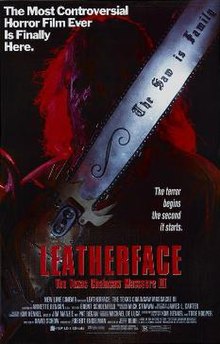
|
|
||||||||||||||||||||
|
|
 |
|
||||||||||||||||||
|
|
||||||||||||||||||||
|
|
|
|
|
|
|
|
|
|
||||||||||||
|
|
|
|
|
|
|
|
|
|||||||||||||
|
|
||||||||||||||||||||
|
#1
|
|||
|
|||
|
Leatherface: The Dystopian Boogeyman
In days of old, the curious thrill-seeker and casual Earth detective went searching for the famed Abominable Snowman, a humanoid ape creature said to be an evolutionary deviant and living high up in snowy mountains.
In today's world, people are curious about the urban phantom --- i.e., "Who is the new Jack the Ripper?" That's because in today's world, pedestrian traffic is of high concern. America is the land of great multi-cultural traffic, and Americans know their country is marked by variegated terrain (swamps, mountains, prairies, deserts, beaches, cities, suburbs, you name it). Hollywood (USA) makes thoroughfare-consciousness films such as "The Texas Chainsaw Massacre" [1974] and "Coming to America" [1988], films that designate a new focus on a profound sense of place and how people view the crossing of space. So who exactly is the new Jack the Ripper? In this thread, I propose that Leatherface, the fictional chainsaw-wielding cannibal from the popular Texas Chainsaw Massacre horror film franchise, is the new phantom (or Jack the Ripper). While Leatherface is not real (while Jack the Ripper was a real serial killer), media/movie images of violence-glorification ominously suggest that an impressionable or psychologically troubled individual just might find the gumption (and mania) to don the mask and mantle of Leatherface one Halloween and go on an American killing spree (with a chainsaw). Copycat crimes are a problem in the modern age. We remember the news stories of copycat crimes modelled after scenes from the controversial Hollywood (USA) film "Natural Born Killers" [1994]. If someone were to 'copy' Leatherface, he just might *be* Leatherface. After all, Leatherface (from the original 1974 Tobe Hooper film) is something like a cross between the Wolfman and the Tin Man. Leatherface stalks random passerby in Texas who happen to cross his path. Leatherface represents a pedestrian paranoia about poor navigation. Leatherface's chainsaw symbolizes a human angst about weapon/power mismanagement. So if Jack the Ripper and the Abominable Snowman preyed on our sensibilities about surroundings, Leatherface haunts our fears about basic trust, making him the new Boogeyman. Therefore, we should be wary (with a degree of irony) about the possibility that a masked Leatherface copycat ghoul may be lurking, waiting to push us into this new age of pedestrian angst. Welcome to the new age!  LEATHERFACE 
|
|
#2
|
||||
|
||||
|
Alltho it bein' pretty arcane, this here's my pick......
|
|
#3
|
||||
|
||||
|
There is a disclaimer at the beginning of TCM saying the story is based on true events. And, without revealing too much, I have encountered Leatherface personally.
|
|
#4
|
||||
|
||||
|
Did you call DCF? It takes a village, Yo.
|
|
#5
|
|||
|
|||
|
Skin-Mask
Leatherface's chainsaw obviously makes him a symbolic hellraiser, but it also seems his eerie predilection to make masks made out of human skin makes him a symbolic witch of some kind.
The skin-mask 'aesthetic' choice does not really seem to be a masquerade (e.g., Halloween/Michael Myers) oriented intelligence/imagination but rather a conscious intention to appear unholy. Doesn't it seem under such criterion that Leatherface is more like Freddy Krueger, while Michael Myers is more like Jason? Strange... |
|
#6
|
||||
|
||||
|
Quote:
|
|
#7
|
||||
|
||||
|
Ya really think so? Cause Ed Gein covers it. And the writers mentioned Gein, Vietnam, etc, but not the Holocaust.
Last edited by Sculpt; 08-19-2016 at 06:27 PM. |
|
#8
|
||||
|
||||
|
I heard an interview with Toby Hooper, in which he mentioned that the inspiration for Leatherface arose from two things.
First, he went on to relate a story the family doctor had told him about having once " skinned off a cadaver's face ", cured it, and wore it to a Halloween party. Second, he said he ( basically ) wanted to have the film feature " a whole family of Ed Geins ". When you examine each individual family member, you will find that they all incorporate seperate aspects of The Ghoul of Plainfield. |
|
#9
|
|||
|
|||
|
Realism
Quote:
But hey if you're using Ed Gein, you might as well think about the Holocaust, that weird family doctor, or even that weird guy from high school (maybe you're the weird guy!). Incidentally, in terms of realism, in the original Hooper film, Leatherface uses two pronounced weapons --- obviously, his symbolic terrifying buzzing chainsaw but also a mighty and devastating mini-sledgehammer. Leatherface wielding a sledgehammer highlights the ghoul's mastery over pure devastation (of the flesh), while the chainsaw represents his 'control' over anarchy and murder (since a chainsaw is both efficient and powerful). In the Hooper film, Leatherface kills two young men with his sledgehammer but one young man (Franklin, in a wheelchair) with his chainsaw. The brutal realism of murder and panic created by the sledgehammer and chainsaw signify Hooper's focus on the relentlessness of Leatherface's mania. Other directors have reinterpreted this use of weapons-based realism. In TCM 3 (1990), Leatherface's chainsaw is presented more as a mystical wand like Excalibur. 
Last edited by Abishai100; 08-13-2016 at 10:43 AM. |
|
#10
|
||||
|
||||
|
Abishai the saw does kind of look like a sword come to think of it.

|
 |
|
|